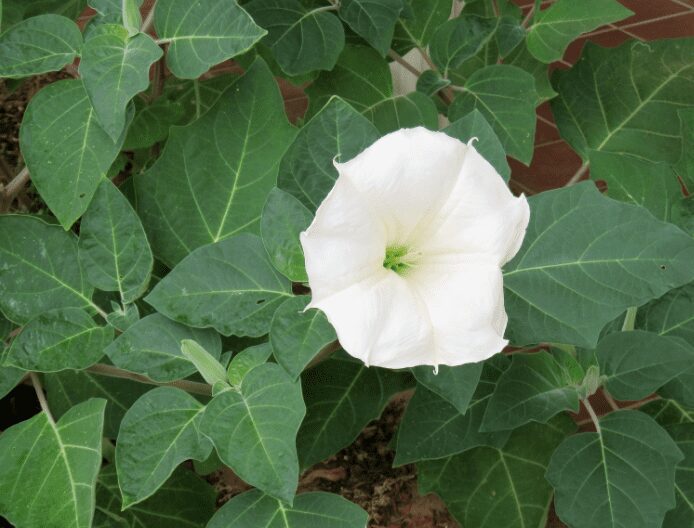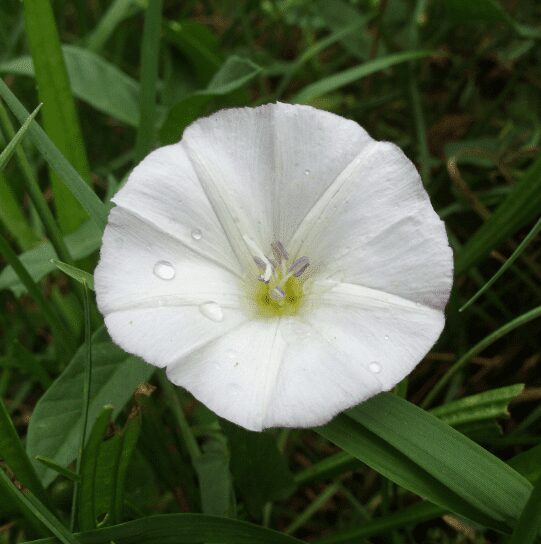
Moonflowers, also known as Ipomoea Alba, are a stunning species of flowering plants that are often grown for their attractive, large, and fragrant white blooms.
They are a popular choice for gardeners and landscapers alike due to their unique appearance and versatility in many different growing conditions.
This comprehensive guide will explore the beauty and benefits of moonflowers and give you a full understanding of how they can be grown and cared for.
What are Moonflowers?
Moonflowers are a species of flowering vine that belong to the Convolvulaceae family. Originally native to tropical and subtropical regions of the world, including South and Central America, but have since been introduced and naturalized in many other parts of the world.
Moonflowers are known for their large, fragrant white flowers that open at night and close in the morning. These flowers are typically 6 to 8 inches in diameter, with five petals arranged in a star shape.
Benefits of Growing Moonflowers
Moonflowers are not only beautiful, but they also provide several benefits to gardeners and the environment. One of the main benefits of growing moonflowers is their ability to attract pollinators, such as moths and hummingbirds, to your garden.
This can help promote a healthy and diverse ecosystem and increase the production of other flowering plants.
In addition to attracting pollinators, moonflowers are fast-growing and easy to care for. They can quickly cover trellises, fences, and other structures, providing a lush and attractive cover for your garden.
Moonflowers are also very versatile and can be grown in various soils and climates, making them an ideal choice for gardeners in different regions.
Growing Moonflowers
Moonflowers are relatively easy to grow and can be started from seeds or cuttings. When starting from seeds, it is best to sow them in the spring, after all danger of frost has passed. The seeds should be planted about 1/4 inch deep in well-drained soil and kept moist until they have germinated. Moonflowers will typically begin to bloom about 60 to 90 days after planting.
If starting from cuttings, it is best to take cuttings in the summer, when the plant is actively growing. The cuttings should be at least 6 inches long and planted in a well-drained soil mixture. They should be kept moist until they have rooted, which can take up to several weeks.
Moonflowers prefer full sun to partial shade and well-drained soil rich in organic matter. They can be fertilized with a balanced fertilizer every 2 to 3 weeks throughout the growing season. To ensure the best growth and flowering, the soil must be evenly moist but not soggy.
The Importance of Soil Preparation for Moonflowers
The success of your moonflower plants will largely depend on the quality of the soil in which they are planted. Proper soil preparation is essential for promoting healthy growth and preventing common problems like wilting and stunted growth. Here are some tips for preparing the soil for your moonflowers:
- Test the soil pH: Moonflowers prefer a slightly acidic soil pH of around 6.0 to 6.5. To test the pH of your soil, your local garden center can provide you with a soil test kit. In case of an excessively high or low pH, you can adjust it by adding garden sulfur or lime as needed.
- Add compost: Compost is an excellent source of nutrients and organic matter that will help improve the quality of your soil. Incorporate a layer of compost into the soil at planting time, and continue to add it to the soil each year to maintain its quality.
- Improve soil drainage: Moonflowers prefer well-draining soil. To improve drainage, you may need to amend heavy clay soil with compost, sand, or perlite.
- Remove weeds and grass: Before planting your moonflowers, remove all weeds and grass from the area. This will help prevent competition for water and nutrients and will make it easier to maintain the plants as they grow.
Caring for Moonflowers
Caring for moonflowers is relatively straightforward. Regular watering and fertilizing is vital for the best growth and flowering, as well as removing any dead or yellowing leaves from the plant. Pruning should be done in the fall to encourage new development in the spring after the plant has finished flowering.
Moonflowers can be susceptible to several pests and diseases, including aphids, spider mites, and powdery mildew. To prevent these issues, it is essential to keep the plants well-ventilated and inspect them regularly for any signs of trouble. If you do notice any issues, it is best to treat them promptly with a natural or organic solution, such as neem oil or horticultural soap.
Keeping an eye on the plant’s growth is also essential, as moonflowers can quickly become invasive in some areas. Regular pruning and training of the vines can help to keep the plant under control and prevent it from taking over your garden.
How to Keep Your Plants Alive Through Winter
Moonflowers are beloved for their enchanting blooms and ease of growth, but overwintering gardeners in cold climates can be challenging. Fortunately, with proper care, it is possible to keep your moonflowers alive through the winter and enjoy their beauty for years to come.
Overwintering Methods
Two main methods for overwintering moonflowers are bringing them indoors or mulching them in the garden.
- Indoor Overwintering: If you want to bring your moonflowers indoors for the winter, it’s best to do so before the first frost. Cut back the plants to about 6 inches, gently remove them from the ground and shake off any excess soil. Re-pot the plants into containers filled with fresh soil and place them in a bright location, such as a sunny window. Water the plants and fertilize them every two weeks to promote healthy growth.
- Garden Overwintering: If you prefer to leave your moonflowers in the garden, protect them from winter’s harsh temperatures by mulching heavily around the base of the plants. Use a thick layer of straw, leaves, or other organic matter to insulate the roots and prevent them from freezing. In the spring, gently remove the mulch and prune back any damaged or dead growth.
Tips for Overwintering Success
Whether you choose to overwinter your moonflowers indoors or in the garden, here are some tips to ensure success:
- Monitor temperature: Moonflowers prefer temperatures between 60-75°F, so keep them in a location that stays within this range.
- Avoid fluctuations: Sudden changes in temperature or humidity can harm moonflowers, so try to maintain a consistent environment for the plants.
- Water sparingly: Overwintered moonflowers will not need as much water as they do during the growing season, so water sparingly allows the soil to dry out slightly between waterings.
- Be patient: Overwintered moonflowers may not begin to grow again until the spring, so be patient and avoid disturbing the plants.
Propagating Moonflower
Moonflowers are not only beautiful, but they are also easy to propagate. By growing new plants from existing ones, you can expand your moonflower collection or share these fantastic flowers with friends and family. Here’s a guide to propagating moonflowers:
Propagation Methods
Moonflowers can be propagated through seeds or cuttings.
- Seed Propagation: Moonflowers are quickly grown from seeds, planted directly in the ground or started indoors. To start moonflower seeds indoors, fill pots with a quality seed-starting mix and plant the seeds about ¼ inch deep. The pots should be in a warm, bright place to moisten the soil. Once the seedlings have emerged, move them to a sunny location.
- Cutting Propagation: Moonflowers can also be propagated from cuttings taken from healthy, mature plants. Cuttings should be taken in the summer when the plant is actively growing. Cut a stem 4-6 inches long and trim the leaves from the bottom half. The cut end of the stem should be dipped in rooting hormone and then planted in a pot filled with a mix of soil and sand that drains well. Place the pot in a bright location and keep the soil moist. Once the cuttings have been rooted, they can be planted in the garden.
Care of Propagated Moonflowers
Whatever propagation method you choose, proper care is essential for success. The following tips will help you care for your propagated moonflowers:
- Water regularly: Make sure the soil is consistently moist, but not soggy.
- Provide plenty of light: To grow appropriately, moonflowers need at least 6 hours of sunlight each day. Place the pots near a sunny window or under grow lights if growing indoors.
- Fertilize: Moonflowers benefit from regular fertilization. Use a balanced fertilizer every two weeks to promote healthy growth.
- Pinch back: Pinch back the tips of the plant when they reach about 6 inches tall. This will encourage bushier growth and promote the development of more flowers.
Using Moonflowers in Your Landscape
Moonflowers can be used in various ways in your landscape, making them a versatile and attractive addition to any garden. Some of the most popular ways to incorporate moonflowers into your garden include:
- Growing them on trellises or fences
- Using them as a ground cover
- Planting them in containers on a patio or deck
- Integrating them into a mixed border or flower bed
Moonflowers can also create a beautiful and colorful garden with other flowering plants, such as roses, clematis, and hibiscus. They can also make a dramatic focal point or as a backdrop for other plants and flowers.
Choosing the Right Moonflower Varieties for Your Garden
With a wide variety of moonflowers available, choosing the right one for your garden can be challenging. Some popular options include:
- Ipomoea alba: Also known as the tropical white moonflower, this variety is known for its large, pure white blooms that can reach up to 6 inches in diameter.

- Ipomoea purpurea: This variety, also known as the common morning glory, produces large, trumpet-shaped blooms in various colors, including pink, purple, blue, and red.

- Ipomoea tricolor: This variety, also known as the heavenly blue morning glory, is popular for its stunning blue blooms and attractive green foliage.

When choosing a moonflower variety, consider the size of your garden, the amount of sunlight it receives, and the type of soil you have. Some moonflowers are more tolerant of shade and moist soil, while others prefer full sun and well-drained soil.
It is also essential to consider the plant’s mature size, since some varieties can grow large and become invasive. If you are concerned about space, consider opting for a dwarf or compact variety, such as Ipomoea minima or Ipomoea rubrocaerulea.
Conclusion
Moonflowers are a beautiful and versatile flowering vine species that can add color, fragrance, and interest to any garden. Whether a seasoned gardener or a novice, growing and caring for moonflowers is relatively easy and can provide you with years of enjoyment. With their large, fragrant blooms and attractive foliage, moonflowers are a must-have for any garden enthusiast.






















